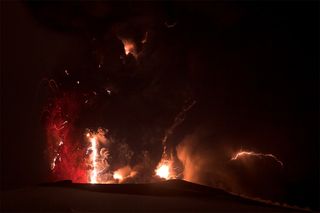Volcano Lightning Strikes — in the Lab

The electrifying displays of lightning often seen over volcanoes have now been experimentally generated in the lab, research that could help shed light on the effects volcanic eruptions have on the landscape, the scientists behind the work say.
The blisteringly hot plumes of ash rising above volcanic eruptions often burst with lightning storms, the largest of which rival the most powerful thunderstorms known on Earth. These natural fireworks might have once helped spark early life on Earth, some scientists think.
Scientists are increasingly analyzing volcanic lightning to better understand volcanic eruptions. Still, much remains unknown about volcanic lightning, since investigators rarely get to see these bolts in nature or get close enough to probe their electrical properties. [Electrifying Images of Volcanic Lightning]
Now, for the first time, scientists have experimentally simulated volcanic lightning in the lab, which could help model the phenomenon's origins and behavior.
The scientists generated the pressurized mixes of air and particles one would expect to find in volcanic plumes and then rapidly decompressed the artificial plumes to standard atmospheric pressure levels, simulating their rush from the mouths of volcanoes. The researchers recorded the results using a high-speed camera and two antennas that helped monitor radio waves from electrical discharges within the gas.
Volcanic plumes generate electricity when ash particles inside the plumes rub against each other. Most everyday static electricity is generated in an analogous way — for instance, when particles of your socks rub against a carpet while you walk across the floor.
"Being able to reproduce lightning under controlled conditions in our experiments means that a rapid progress can be expected in the understanding of this phenomenon,"study lead author Corrado Cimarelli, a volcanologist at Ludwig Maximilian University in Munich, Germany, told LiveScience.
Sign up for the Live Science daily newsletter now
Get the world’s most fascinating discoveries delivered straight to your inbox.
The number of electrical discharges observed in the experiment rose proportionally with the amount of fine ash particles included in the artificial plumes. This suggests that monitoring lightning over active volcanoes could help detect fine ash from eruptions, as well as the rate at which ash is spewed out, two details that are currently very difficult for researchers to estimate, Cimarelli said. This ash can have global effects — for instance, the ash plume from Iceland's Eyjafjallajökull volcano paralyzed flights across Europe.
Future research could simulate different types of eruption conditions. "This should go in parallel with the incorporation of electrical properties of volcanic particles into existing computer simulation of volcanic plumes," Cimarelli said.
The scientists detailed their findings online Dec. 6 in the journal Geology.
Follow us @livescience, Facebook & Google+. Original article on LiveScience.

Most Popular




